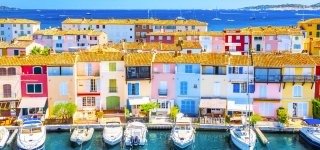The town of Grimaud
Village dating back to medieval times, the village of Grimaud is still dominated by the silhouette of its feudal castle in ruins and its walls with battlements. Located on the hills between Sainte-Maxime and Saint-Tropez, the old village of Grimaud offers from multiple points of view a magnificent view of one of the most famous bays of the Mediterranean. The village center undoubtedly invites you to stroll among its abundance of flowers of bougainvillea and shaded squares. Every street detour is the opportunity to discover a small preserved heritage: a fountain, a sundial, a medieval arch. The Saint-Michel is the oldest Romanesque building from the Gulf of St. Tropez. Built in the late 12th century, it includes a large furniture and a remarkable organ. Grimaud Castle site, like frozen in time, is a pleasant place to walk and also the subject of thematic tours. Among the remarkable rural heritage Grimaud face the windmill Saint-Roch for the working of wheat.
Around the village, the landscape is dominated by vineyards Grimaud wines, famous around the world, have for centuries been at the heart of the territory grimaudois economy. Several prestigious estates open their vineyards and cellars to visit: Val de Gilly, La Tourre, Clos Servian or Pré Saint Michel. The ancestral cultivation of olive trees is itself represented by a top local producer.
Grimaud Heritage Museum is the ideal site to discover Provençal traditions and rural life of past centuries. Housed in an oil mill of the 16th century and an old forge, it has a large collection of objects and everyday tools and organizes exciting temporary exhibitions.
Sea side, Port Grimaud offers a different face, very different charm. The visit of the lagoon city is a must in the Gulf of St. Tropez. Built in the 60s, Marina Grimaud was designed in a typical Provencal style by architect François Spoerry. Labeled "Heritage of the 20th century", it fits perfectly into the surrounding Mediterranean décor. The city was built in a swampy area. The buildings were built on land, and sea water then channeled through canals. Typical Provencal materials were used to fully integrate the city to the Mediterranean and give it a timeless aesthetic. Materials and construction elements such as tiles, tiles and ironwork could be eg salvaged from demolition sites around. The Marina is a real village on the water, with seats, an ecumenical church, shops and residential houses. All the houses are lined with docks and accessible both from land and from the water. A boat ride is also one way to visit Port Grimaud without risking not miss anything. Important elements of the heritage of the lakeside city include the fountain and ceramic decorations instead François Spoerry, instead of 14 June, the windows of Vasarely in the St. Francis of Assisi Church, or the pretty wrong -l'œil qu'arborent some facades.
The tourist train makes seasonal several daily connections between the medieval village of Grimaud and the marina of Port Grimaud.
Both sites offer a rich event programming throughout the year, especially in summer: the fair wool, traditionally held on Ascension Thursday, mixes eg Provencal folklore and local markets. Other highlights of the year included the Festival of Grimaud Grimaldines, musical evenings Grimaud, the feast of St. Michael held the last Sunday of September, the organic fair, the weekend of the nose or the festival of light that takes place in any season.
